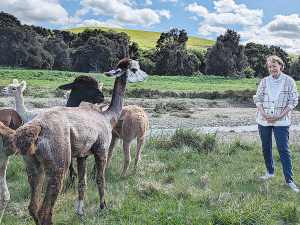Scaled-back show meets targets
Organisers of the Christchurch A&P show say they are happy with this year’s event despite a rushed turnaround that left agricultural industry support thin on the ground.
 The 2023 Agricultural Show president, alpaca breeder Anne Rogers, with a mob of her ‘’mums and bubs” on the farm at Sefton, near Rangiora. Photo Credit: Nigel Malthus
The 2023 Agricultural Show president, alpaca breeder Anne Rogers, with a mob of her ‘’mums and bubs” on the farm at Sefton, near Rangiora. Photo Credit: Nigel Malthus
A love of animal fleece is the driver for Anne Rogers who is this year’s President of the Canterbury A&P’s New Zealand Agricultural Show.
Rogers, an alpaca breeder, sings the praises of alpaca fleece – very high tensile strength, very fine, very soft. However, the longtime alpaca convenor for the show emphasises that she loves the fleece of all animals.
Just the second woman to take the reins as show president, Rogers and her husband Bevan started their alpaca journey when they bought five wethers for their first lifestyle block in the late 1990s.
“And then we kind of got bitten by the bug,” she says.
They then invested in some breeding females, using outside studs, before importing their own males from Australia.
Since then, they have used a combination of their own and imported genetics in an effort to improve their stock.
Rogers told Rural News that while New Zealand has some large-scale commercial alpaca farms there are also many lifestylers with just a few alpacas, as a very interactive animal that people enjoy as pets and “nice lawnmowers”.
Having exported fibre to Norway, Germany and Italy, she describes their farm as being at the higher end of the lifestyle scale.
“For us, the fibre is the driver. We love the animals themselves, but we also really love their fleeces.”
A feature of alpaca fleece is a range of microns in the same fleece. Some harder, stronger fibres among the soft can give a garment a prickly feel.
Rogers says the main aim of alpaca breeders at the moment is to reduce the strength of those primary fibres and improve the uniformity of the micron and fibre length across the fleece.
The Rogers have also specialised into trying to breed for grey fibre, but it has been even harder to find the breeding stock for that, she says.
“They may not be grey themselves, some of the studs we’ve used, but that grey colour will come into the next generation.”
She says that while they could be termed lifestyle farmers, they have put a lot into trying to upgrade the quality of their fleeces.
“We’ve managed to achieve it with some of our animals, not with all of them,” Rogers explains. “We’ve got beautiful fleeces that are nice and deep, some great coverage and a wonderful crimp style, but some of them have got those strong black fibres in them.”
They currently have 32 animals. “We’ve cut down a little bit. I think the maximum we ever got to was about 42 or 45, but we try to keep it manageable for the two of us.”
Both Anne and Bevan have ‘day jobs’. He’s the principal doctor and she the practice manager at the medical centre they own in Rangiora.
Wool's Time To Shine!
As show president, Rogers has been instrumental in a major revamp of the show’s Wool Zone this year.
It is something she has been “passionate about for many years,” she says.
By moving the popular City Farmyard experience – where children can interact directly with young animals – out to their own expanded children’s display area, more space has been made in the sheep pavilion for the expanded Wool Zone. Described as an immersive 160 years’ celebration of wool, it will showcase the history of fibre farming from its beginnings to modern uses such as fibre reinforcing in plastic composites.
Rogers told Rural News that it’s a collaborative exercise between the wool and fibre section, the trade section, the home industry section and commercial entities – including NZ Merino sponsoring a big alpaca experience.
Live displays will include spinners and weavers, as well as hand blade shearing demonstrations.
“It’s bringing the competition fleeces into the same area next to the sheep which is a really good idea and we finally managed to achieve it,” Rogers explains.
She claims the change has come about through her “rabbiting on about it” for the last four or five years.
“We need to do something with wool. We need to support our local wool producers and New Zealand wool producers and really, it’s wool’s time to shine,” Rogers adds.
Grace Su, a recent optometry graduate from the University of Auckland, is moving to Tauranga to start work in a practice where she worked while participating in the university's Rural Health Interprofessional Programme (RHIP).
Two farmers and two farming companies were recently convicted and fined a total of $108,000 for environmental offending.
According to Ravensdown's most recent Market Outlook report, a combination of geopolitical movements and volatile market responses are impacting the global fertiliser landscape.
Environment Canterbury, alongside industry partners and a group of farmers, is encouraging farmers to consider composting as an environmentally friendly alternative to offal pits.
A New Zealand dairy industry leader believes the free trade deal announced with India delivers wins for the sector.
The Coalition Government will need the support of at least one opposition party to ratify the free trade deal with India.

OPINION: The release of the Natural Environment Bill and Planning Bill to replace the Resource Management Act is a red-letter day…
OPINION: Federated Farmers has launched a new campaign, swapping ‘The Twelve Days of Christmas’ for ‘The Twelve Pests of Christmas’ to…